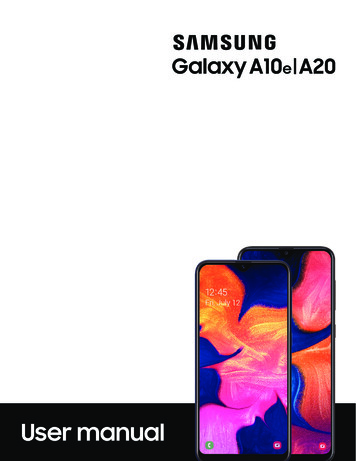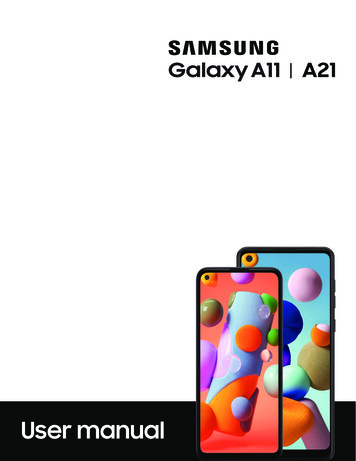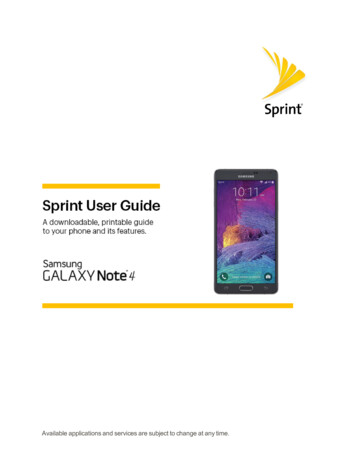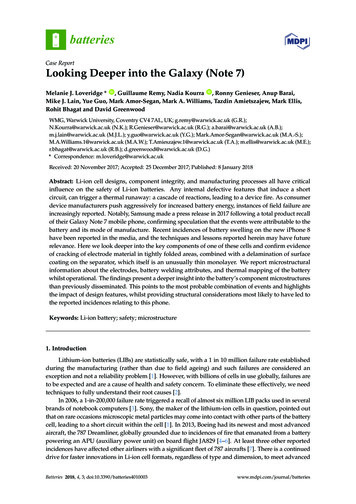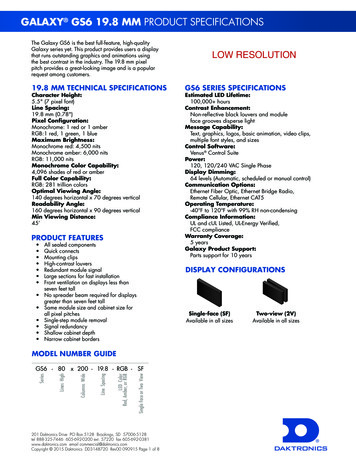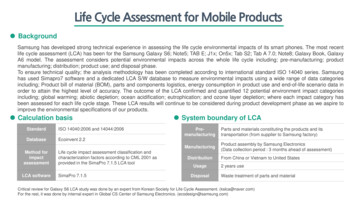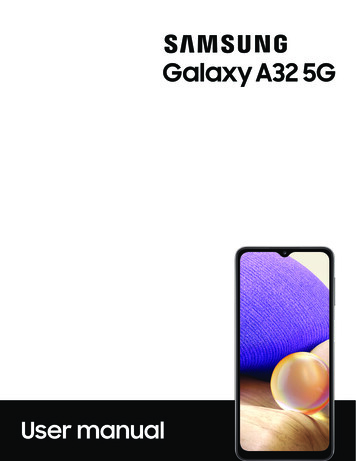
Transcription
User manual
ContentsFeaturesMobile continuity Biometric security Dark modeGetting startedDevice layout: Galaxy A32 5GSet up your device: Charge the batteryStart using your device: Turn on your device Use the Setup Wizard Transfer data froman old device Lock or unlock your device Accounts Set up voicemail Navigation Navigation bar Customize your home screen Digital wellbeing and parental controls Biometric security Mobile continuity Multi window Edge panels Enter text EmergencymodeCustomize your home screen: App icons Wallpaper Themes Icons Widgets Homescreen settings Easy mode Status bar Notification panelCamera and GalleryCamera: Navigate the camera screen Configure shooting mode AR Zone Record videos Camera settingsGallery: View pictures Edit pictures Play video Edit video Share pictures and videos Delete pictures and videos Group similar images Take a screenshot Screen recorderMobile continuityLink to Windows Continue apps on other devices2SAM A326 EN UM TN UB9 032221 FINAL
ContentsSamsung appsGalaxy Essentials AR Zone Galaxy Store Galaxy Wearable Game Launcher Samsung Free Samsung Global Goals Samsung Members SmartThings Calculator Calendar Clock Contacts Internet Messages My Files Phone Samsung Health Samsung Notes Samsung PayGoogle appsChrome Drive Duo Gmail Google Maps Photos Play Movies & TV Play Store YouTube YT MusicMicrosoft appsOutlook LinkedIn Office OneDriveSettingsConnections: Wi-Fi Bluetooth NFC and payment Airplane mode Mobile networks Data usage Mobile hotspot Tethering Nearby device scanning Connect to a printer Virtual Private Networks Private DNS Ethernet Network unlockCustomization: Display Notifications Sounds and vibrationSecurity: Lock screen and security Face recognition Fingerprint scannerAccounts: Add an account Account settings Remove an account Backup and restore Google settingsBackup: Samsung account Google Account External storage transferAccessibility: Recommended for you TalkBack Visibility enhancements Hearingenhancements Interaction and dexterity Advanced settings Installed services AboutAccessibilityOther: Help Android Auto Dual Messenger About phoneLearn moreLegal information3
Getting startedGalaxy A32 5GSet up your deviceStart using your device4
Getting startedGalaxy A32 5GFront cameraVolume keysSide key/FingerprintscannerRear camerasFlashUSB charger/Audio portDevices and software are constantly evolving — the illustrations you see here are for reference only.5
Getting startedSet up your deviceCharge the batteryYour device uses a nano-SIM card. A SIM card may be preinstalled, or you may be ableto use your previous SIM card. Contact your carrier for more details.Install SIM/microSD cardPlace the SIM card andoptional microSD card(sold separately) intothe tray with the goldcontacts facing down.SIMmicroSDCharge your deviceBefore turning on yourdevice, charge it fully.NOTE The use of mobile devices on an aircraft or a ship may be subject tofederal and local guidelines and restrictions. Check with appropriate authoritiesand always follow crew instructions regarding when and how you may use yourdevice.Devices and software are constantly evolving — the illustrations you see here are for reference only.6
Getting startedNOTE Use only Samsung-approved chargers and cables. To avoid injury ordamage to your device, do not use incompatible, worn or damaged batteries,chargers or cables. Using other charging devices and batteries may void yourwarranty and may cause damage. For more information on your device, includingcharging compatibility, please visit samsung.com.Charge the batteryYour device is powered by a rechargeable battery.TIP While charging, the device and the charger may become hot and stopcharging. This usually does not affect the device’s lifespan or performance and isin the device’s normal range of operation. Disconnect the charger from the deviceand wait for the device to cool down. For more information, rt using your deviceTurn on your device Use the Setup Wizard Transfer data from an old device Lock orunlock your device Accounts Set up voicemail Navigation Navigation bar Customizeyour home screen Digital wellbeing and parental controls Biometric security Mobilecontinuity Multi window Edge panels Enter text Emergency modeTurn on your deviceUse the Side key to turn your device on. Do not use the device if the body is cracked orbroken. Use the device only after it has been repaired. Press and hold the Power key to turn the device on. To turn the device off, press and hold the Side key Confirm when prompted.Power off. To restart your device, press and hold the Side key Confirm when prompted.Restart.7
Getting startedUse the Setup WizardThe first time you turn your device on, the Setup Wizard guides you through the basicsof setting up your device.Follow the prompts to choose a default language, connect to a Wi-Fi network, set upaccounts, choose location services, learn about your device’s features, and more.Transfer data from an old deviceUse Smart Switch to transfer contacts, photos, music, videos, messages, notes,calendars, and more from your old device. Smart Switch can transfer your data viaUSB cable, Wi-Fi, or computer.Visit samsung.com/us/support/owners/app/smart-switch to learn more.1. From Settings, tapAccounts and backup Bring data from old device.2. Follow the prompts and select the content to transfer.Visit samsung.com/smartswitch for more information.8
Getting startedLock or unlock your deviceUse your device’s screen lock features to secure your device. By default, the devicelocks automatically when the screen times out. For more information about screenlocks, see Lock screen and security.Side key/FingerprintscannerPress to lock.Press to turn on thescreen, and then swipethe screen to unlock it.Devices and software are constantly evolving — the illustrations you see here are for reference only.9
Getting startedAccountsSet up and manage your accounts.TIP Accounts may support email, calendars, contacts, and other features. Contactyour carrier for more information.Add a Google AccountSign in to your Google Account to access your Google Cloud Storage, apps installedfrom your account, and make full use of your device’s Android features.1. From Settings, tap2. TapAccounts and backup Manage accounts.Add account Google.NOTE When you sign in to a Google Account, Factory Reset Protection (FRP) isactivated. FRP requires your Google Account information when resetting tofactory settings. For more information, see Factory Reset Protection.Add a Samsung accountSign in to your Samsung account to access exclusive Samsung content and make fulluse of Samsung apps. From Settings, tap Samsung account.Add an Outlook accountSign in to your Outlook account to view and manage email messages.1. From Settings, tap2. TapAccounts and backup Manage accounts.Add account Outlook.10
Getting startedSet up voicemailYou can set up your voicemail service when you access it for the first time. You canaccess voicemail through the Phone app. Options vary by carrier.1. FromPhone, touch and hold the1 key or tapVoicemail.2. Follow the tutorial to create a password, record a greeting, and record yourname.11
Getting startedNavigationA touch screen responds best to a light touch from the pad of your finger or acapacitive stylus. Using excessive force or a metallic object on the touch screen maydamage the surface of the screen and the damage will not be covered by thewarranty.TapLightly touch items to select or launch them.lTap an item to select it.lDouble-tap an image to zoom in or out.Devices and software are constantly evolving — the illustrations you see here are for reference only.12
Getting startedSwipeLightly drag your finger across the screen.lSwipe the screen to unlock the device.lSwipe the screen to scroll through the Home screens or menu options.Devices and software are constantly evolving — the illustrations you see here are for reference only.13
Getting startedDrag and dropTouch and hold an item, and then move it to a new location.lDrag an app shortcut to add it to a Home screen.lDrag a widget to place it in a new location.Devices and software are constantly evolving — the illustrations you see here are for reference only.14
Getting startedZoom in and outBring your thumb and forefinger together or apart on the screen to zoom in and out.lMove your thumb and forefinger together on the screen to zoom out.lMove your thumb and forefinger apart on the screen to zoom in.Devices and software are constantly evolving — the illustrations you see here are for reference only.15
Getting startedTouch and holdTouch and hold items to activate them.lTouch and hold a field to display a pop-up menu of options.lTouch and hold a Home screen to customize the Home screen.Devices and software are constantly evolving — the illustrations you see here are for reference only.16
Getting startedNavigation barYou may navigate your device by using either the navigation buttons or full screengestures.BackRecent appsHomeDevices and software are constantly evolving — the illustrations you see here are for reference only.17
Getting startedNavigation buttonsUse buttons along the bottom of the screen for quick navigation.1. From Settings, tapDisplay Navigation bar Buttons.2. Tap an option under Button order to choose which side of the screen the Backand Recent apps icons display.Navigation gesturesHide the navigation buttons at the bottom of the screen for an unobstructed screenexperience. Instead swipe to navigate your device.1. From Settings, tapfeature.Display Navigation bar Swipe gestures to enable the2. Tap an option to customize:lllMore options: Choose a gesture type and sensitivity.Gesture hints: Display lines at the bottom of the screen where each screengesture is located.Show button to hide keyboard: Show an icon on the bottom right corner ofthe screen to hide the keyboard when the device is in portrait mode.18
Getting startedCustomize your home screenThe Home screen is the starting point for navigating your device. You can place yourfavorite apps and widgets here, in addition to setting up additional Home screens,removing screens, changing the order of screens, and choosing a main Home screen.App icons Wallpaper Themes Icons Widgets Home screen settings Easy mode Status bar Notification panelApp iconsUse app icons to launch an app from any Home screen. From Apps, touch and hold an app icon, and tapAdd to Home.To remove an icon: From a Home screen, touch and hold an app icon, and then tapRemove.NOTE Removing an icon does not delete the app, it just removes the icon from aHome screen.WallpaperChange the look of the Home and Lock screens by choosing a favorite picture, video,or preloaded wallpaper.1. From a Home screen, touch and hold the screen, and then tapWallpapers.2. Tap one of the following menus for available wallpapers: My wallpapers: Choose from featured and downloaded wallpapers. Gallery: Choose pictures and videos saved in the Gallery app. Wallpaper services: Enable additional features including guide page andDynamic Lock screen. Apply Dark mode to Wallpaper: Enable to apply Dark mode to your wallpaper. Explore more wallpapers: Find and download more wallpapers from GalaxyThemes.19
Getting started3. Tap a picture or video to choose it. If choosing a single picture, choose which screen or screens you want toapply the wallpaper to. Videos and multiple pictures can only be applied to the Lock screen. If choosing videos or pictures from the Gallery, tap on one or more items, andthen tap Done.4. Tap Set on Home screen, Set on Lock screen, or Set on Lock and Home screens(depending on which screens are applicable). If applying a picture from the Gallery to both the Home and Lock screens,enable Sync my edits if you want any edits made to that wallpaper to beapplied to both screens.ThemesSet a theme to be applied to your Home and Lock screens, wallpapers, and app icons.1. From a Home screen, touch and hold the screen.2. TapThemes, and tap a theme to preview and download it.3. TapNavigation drawer My stuff Themes to see downloaded themes.4. Tap a theme, and then tap Apply to apply the selected theme.IconsApply different icon sets to replace the default icons.1. From a Home screen, touch and hold the screen.2. TapThemes Icons, and tap an icon set to preview and download it.3. TapNavigation drawer My stuff Icons to see downloaded icons.4. Tap an icon, and then tap Apply to apply the selected icon set.20
Getting startedWidgetsAdd widgets to your home screens for quick access to info or apps.1. From a Home screen, touch and hold the screen.2. TapWidgets, and then tap a widget set to open it.3. Swipe to the widget you want to add to the Home screen, and tap Add.Customize WidgetsOnce you have added a widget, you can customize where it's located and how itfunctions. From a Home screen, touch and hold a widget, and tap an option: Remove: Delete a widget from your screen. Settings: Customize the function or appearance of the widget. App info: Review the widget usage, permissions, and more.Home screen settingsCustomize your Home and Apps screens.1. From a Home screen, touch and hold the screen.2. TapSettings to customize: Home screen layout: Set your device to have separate Home and Appsscreens, or only a Home screen where all apps are located. Home screen grid: Choose a layout to determine how icons are arranged onthe Home screen. Apps screen grid: Choose a layout to determine how icons are arranged onthe Apps screen. Show Apps screen button on Home screen: Add a button to the Home screenfor easy access to the Apps screen. Lock Home screen layout: Prevent items on the Home screen from beingremoved or repositioned. Add new apps to Home screen: Automatically add newly-downloaded apps tothe Home screen.21
Getting started Hide apps: Choose apps to hide from the Home and App screens. Return tothis screen to restore hidden apps. Hidden apps are still installed and canappear as results in Finder searches. App icon badges: Enable to show badges on apps with active notifications.You can also choose the badge style. Swipe down for notification panel: Enable this feature to open theNotification panel by swiping down anywhere on the Home screen. Rotate to landscape mode: Rotate the Home screen automatically when yourdevice’s orientation is changed from portrait to landscape. About Home screen: View version information.22
Getting startedEasy modeThe Easy mode layout has larger text and icons, making for a more straightforwardvisual experience. Switch between the default screen layout and a simpler layout.Apps list1. From Settings, tap2. TapDisplay Easy mode.to enable this feature. The following options appear: Touch and hold delay: Set how long it takes for a continuous touch to berecognized as a touch and hold. High contrast keyboard: Choose a keyboard with high contrast colors.Devices and software are constantly evolving — the illustrations you see here are for reference only.23
Getting startedNotification panelFor quick access to notifications, settings, and more, simply open the Notificationpanel.Device settingsQuick settingsNotification cardsDevices and software are constantly evolving — the illustrations you see here are for reference only.24
Getting startedView the Notification panelYou can access the Notification panel from any screen.1. Swipe down on the screen to display the Notification panel. To open an item, tap it. To clear a single notification, drag the notification left or right. To clear all notifications, tap Clear. To customize notifications, tap Notification settings.2. Drag upward from the bottom of the screen or tapNotification panel.Back to close theFinger sensor gesturesYou can also open or close the Notification panel by swiping up or down on thefingerprint sensor.1. From Settings, tapgestures.2. TapAdvanced features Motions and gestures Finger sensorto enable the feature.Quick settingsThe Notification panel provides quick access to device functions using Quick settings. Swipe down with two fingers from the top of the screen to display Quicksettings. TapFinder search to search the device. TapPower off for Power off, Emergency mode, and Restart options. Tap TapOpen settings to quickly access the device's settings menu.More options to reorder Quick settings or to change the button layout. Tap Devices to control other devices when supported apps like SmartThingsor Google Home are installed. Tap Media to access the Media panel and control playback of connectedaudio and video devices. Tap a quick setting icon to turn it on or off.25
Getting started Touch and hold a quick setting icon to open the setting. Drag the Brightness slider to adjust the screen brightness.26
Getting startedStatus barThe Status bar provides device information on the right side and notification alerts onthe left.Status iconsBattery fullAirplane modeChargingMuteBluetooth activeLocation activeMissed callsCall in progressNew messageNew emailDownloadVibrateAlarmNotification iconsUploadVoicemailApp updateConfigure display options for the Status bar.TIP From Quick settings, tap More options Status bar to configure settingsfor Status bar notifications. For more information, see Advanced settings.27
Getting startedDigital wellbeing and parental controlsYou can monitor and manage your digital habits by getting a daily view of howfrequently you use apps, how many notifications you receive, and how often you checkyour device. You can also set your device to help you wind down before going to bed. From Settings, tapDigital Wellbeing and parental controls for the followingfeatures: Tap the Dashboard to view the following:– Screen time: View how long an app has been opened and used each day.– Notifications received: View how many notifications have been receivedfrom an app each day.– Unlocks: View how many times an app has been opened each day.Your goals Screen time: Set a screen time goal and view your daily average. App timers: Set a daily limit for how long you use each app.Ways to disconnect Focus mode: Limit app usage for set periods of time to avoid distractions fromyour device. Bedtime mode: Schedule when to change the screen to grayscale and mutecalls, alerts, and other sounds.Check on your kids Parental controls: Supervise your children’s digital life with Google’s FamilyLink app. You can choose apps, set content filters, keep an eye on screentime, and set screen time limits.28
Getting startedBiometric securityUse biometrics to securely unlock your device and log in to accounts.Face recognitionYou can enable Face Recognition to unlock your screen. To use your face to unlockyour device, you must set a pattern, PIN, or password. Face recognition is less secure than Pattern, PIN, or Password. Your device couldbe unlocked by someone or something that looks like your image. Some conditions may affect face recognition, including wearing glasses, hats,beards, or heavy make-up. When registering your face, ensure that you are in a well-lit area and the cameralens is clean.1. From Settings, tapBiometrics and security Face recognition.2. Follow the prompts to register your face.Face recognition managementCustomize how face recognition works. From Settings, tapBiometrics and security Face recognition. Remove face data: Delete existing faces. Add alternative look: Enhance face recognition by adding an alternativeappearance. Face unlock: Enable or disable face recognition security. Stay on Lock screen until swipe: When you unlock your device with facerecogniti
From Phone, touch and hold the 1 key or tap Voicemail. 2. Follow the tutorial to create a password, record a greeting, and record your name. 11 Gettingstarted. Navigation. A touch screen responds best to a light touch from the pad of your finger or a capacitive stylus. Using exc
